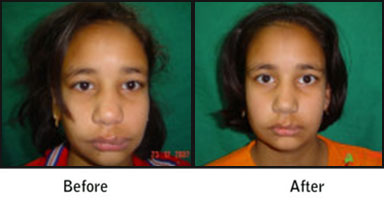Haemangiomas India
Lasers for Vascular Anomalies (Haemangiomas and Port Wine Stain)
Vascular lesions are the most common cutaneous abnormalities in neonates.
Vascular anomalies should be properly identified, since the diagnosis predicts the biologic course and affects decisions about the interventions that can be implemented.
Most of the time, the clinical appearance and clinical course are sufficient in determining an accurate diagnosis. Lesions that are present at birth and appear to grow at the same rate as the rest of the body are usually vascular malformations, whereas lesions that develop within the first few weeks of life that increase in size asynchronously are typically hemangiomas.
Hemangiomas
These are the most common vascular anomaly, affecting up to 12% of all children by 1 year of age. There is a female predominance, with a 3:1 ratio compared to affected males. Sixty percent of all hemangiomas are found in the head and neck region. Complications that may be associated with hemangiomas include ulceration, bleeding, scarring, and infection.
Treatment of Hemangiomas
Laser provide an important therapeutic approach for hemangiomas. The flash lamp pulsed dye, the KTP, argon, alexandrite and Nd:YAG lasers have been reported to be quite effective. The wavelength, power output of the laser system, spot size and exposure times are important factors in determining the effectiveness.
Longer wavelength lasers can penetrate deeper and may be better suited for thicker lesions and deeper, larger vessels. We at Saraswat Hospital use the Nd:YAG laser, emitting a wavelength of 1064 nm, which has several theoretical advantages. The longer wavelength can enable deeper penetration into the dermis. Oxyhemoglobin absorption has a peak at 1064 nm while melanin absorption decreases at longer wavelengths, so the risk of post treatment hyperpigmentation is decreased at 1064 nm. This is especially helpful in the treatment of darker skin types, where the risk of pigmentary alteration is high.
The Nd:YAG laser is available as continuous or pulsed beams and can penetrate to a depth of 4-6 mm to coagulate deeper, larger vessels. Continuous wave Nd:YAG lasers cause shrinkage of hemangiomas primarily by nonspecific thermal damage.
Saraswat Hospital Agra has been treating such haemangiomas for past more than a decade.
Port Wine Stain
They are a type of capillary vascular malformation and are present since birth. They do not resolve. Any part of the body can get affected but the head and the neck is the most common site of involvement.
Treatment
Nodular port wine stains were reported to respond better to the 1064 nm Nd:YAG laser than flat port wine stains after one treatment.
Just as other vascular malformations Saraswat Hospital Agra has a huge experience of treating infants and children presenting with port wine stain.












